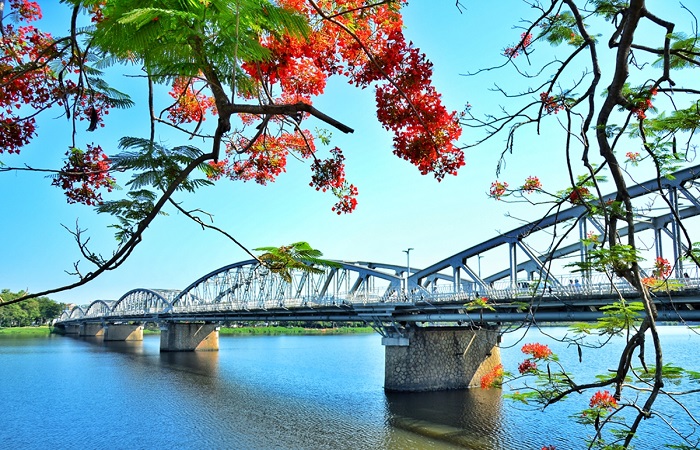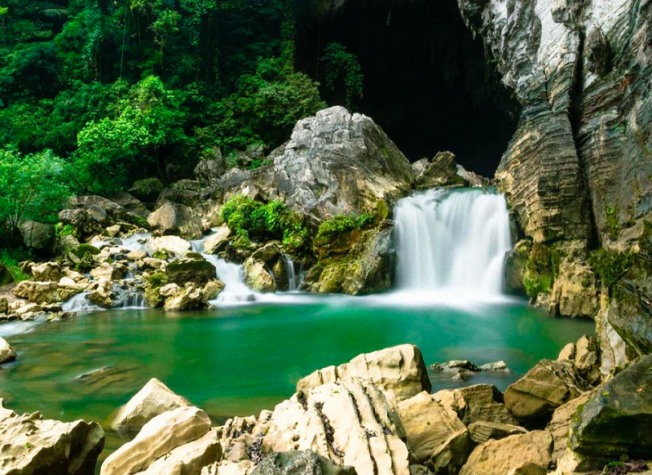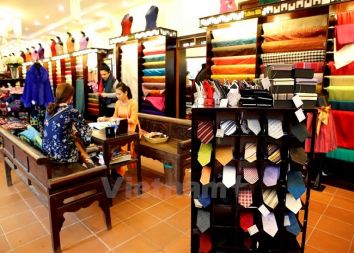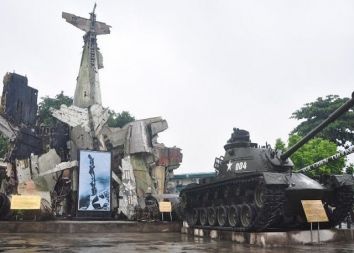Truong Tien Bridge and Perfume River in Hue City, Vietnam
Truong Tien Bridge or Trang Tien Bridge is a 402.60 m long bridge, consisting of 6 comb-shaped steel beams with an aperture of 67 m each. The bridge is 6 m wide, designed in Gothic architecture, spanning the Perfume River. The northern bridgehead is in Dong Ba ward, the southern bridgehead is in Phu Hoi ward in the center of Hue city, Thua Thien Hue province, Vietnam.

Perfume River (Hương River) originates from the Truong Son Dong mountain range. The main stream is Ta Trach with a length of 67km, originating from the Truong Son Dong range, along the Bach Ma area to the northwest, through Nam Dong town. Then it merges with Huu Trach stream with a length of 60km in the North through Bang Lang junction. At the place where these two streams meet to form the Perfume River.
Why is It called Perfume River? Since ancient times, the Perfume River in Hue flows through many forests with many herbs with the fragrance of natural flowers and plants, so when entering Hue city, the river brings with it its natural fragrance and hence its name. Perfume River was born.

History and Names of Trang Tien Bridge in Hue:
Based on the poem "Thuan Hoa becomes a matter" of poet Thai Thuan, poet Quach Tan said that under King Le Thanh Tong, the Perfume River had a bridge. That bridge, made of rattan rattan tightly tied together and connected, should be named Cloud Bridge. Because the bridge is shaped like a rainbow facing the river, it is also called Mong bridge. Over the years, I don't know when, Mong bridge was rebuilt by wood, the bridge surface is paved with ironwood planks.
This whole iron bridge was designed by Schneider et Cie et Letellier, started in May 1899 and inaugurated on December 18, 1900. Basically, the bridge has 6 blocks, each of which is 66.66 meters long. The bridge deck is 4.5 m wide and has two curbs on both sides, 0.75 m wide on each side. Completion cost is 732,456 Francs
The flood in the year of the Dragon (September 11, 1904) destroyed 2 arches of the bridge. Then Mr Daydéet Pillé was assigned to repair the remaining two arches of bridges and build four other new arches in the old style.
In 1907, when King Thanh Thai was exiled by the French to Réunion Island, the French colonial government renamed it Clémenceau Bridge, after Georges Clemenceau, a French Prime Minister during World War I.
In the years 1905-1915, the bridge deck was covered with reinforced concrete. The bridge was degraded due to rust and increasing traffic, so the government at that time negotiated with the Eiffel Firm (then named Levallois Perret Construction Company - La Société Constructions Levallois-Perret) to find a way to repair it. this bridge. Accordingly, the experts decided: to replace the damaged iron beam frames, reinforced cement cast-iron bridge deck, wider roadbed, two sidewalks for pedestrians 1.95 wide, make it outside. and each pier must be widened to make a shelter. The entire bridge is coated with many layers to prevent rust. The upgrade cost this time is $435,000.
On June 20, 1937, the Eiffel Company - then named Anciens Etablissements Eiffel - under the command of director - engineer Martin André carried out the construction of the bridge expansion. In November 1939, after 29 months of construction, Trang Tien Bridge was completed.
In 1945, the government of Tran Trong Kim changed its name to Nguyen Hoang Bridge. In 1946, during the Vietnam-France war, the bridge was mined by the Viet Minh and demolished two spans on the left bank. Two years later, the bridge was temporarily repaired for traffic. In 1953, the bridge was completely repaired as before.
During the Tet Offensive, the 3rd and 4th arches were destroyed, when the Southern Liberation Front forces collapsed to cut off the counterattack of the Republic of Vietnam army. After that, a pontoon bridge was temporarily erected next to it to connect the two banks; then the bridge was temporarily repaired.

In 1991 the bridge was restored. In this restoration by the Thang Long Bridge 1 Company, which lasted for 5 years (1991-1995), there were many important changes, that is, the removal of balconies in the corridors on both sides at the location of the main buildings. piers and bridges (both main and side roads) are narrowed due to the need to brace two more railing pipes, the paint color is gray instead of the original color of the bridge, which is silver emulsion...
Since the Hue Festival in 2002, Trang Tien Bridge has been installed with a modern color changing lighting system. Walking along Perfume River or crossing Phu Xuan Bridge, then you can see beautiful colors changing. This is one of the Best Hue Tourist Attraction at Night Time.
See Also:

Best of Vietnam

Best Vietnamese Food You Have to Try in Vietnam
Best Food in Vietnam: Vietnamese Traditional Food is top World well known to be both healthy and...

10 Best National Parks in Vietnam
Vietnam Travel Guide: If you look for the Best Wildlife Discovery Experience in Vietnam, here are...
Read More
Best Souvenir to Buy in Vietnam
If you look for Best Things to Buy when traveling to Vietnam to bring home for your family & friends...
Read More
The 10 Best Places to Visit in Vietnam
Vietnam Travel Guide: Home to an extensive collection of historical and cultural attractions,...
Read More
Top 10 Museums You Should Not Miss in Vietnam
Vietnam, 4.000 years old country has a unique and lengthy history, culture with 54 ethnic groups. It...
Read MoreFind your trip
Vietnam Best Tours
Vietnam Car Rental
Vietnam Travel Blog
- Vietnamese People: Origin, History, Culture and Traditions
- Vietnam Currency: Best ATM and Places to Exchange Money
- Vietnam Map: Regions, Cities & Provinces Map of Vietnam
- What is illegal Things in Vietnam: Rules & Laws for Tourists
- Best Time to Travel to Vietnam to Avoid the Bad Weather
- Vietnam News: Population & Religions of 54 Ethnic Groups









